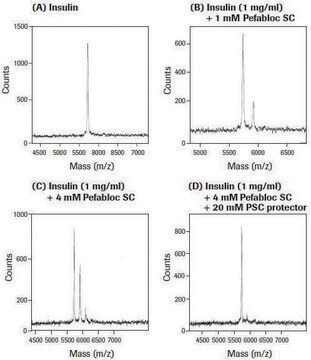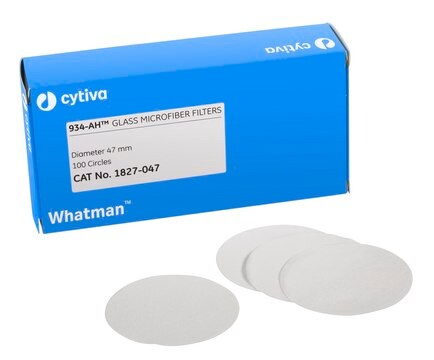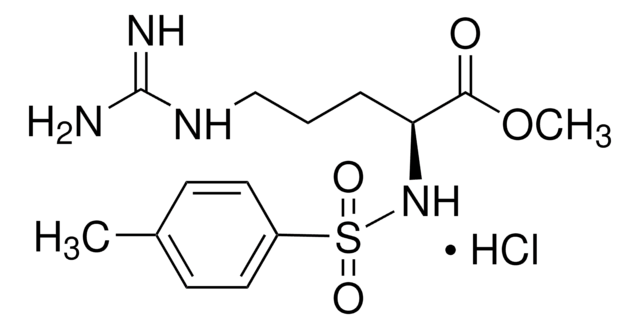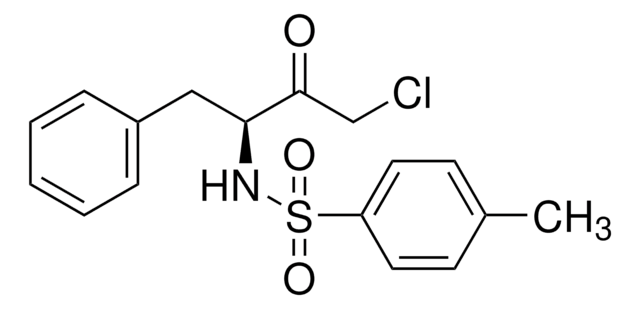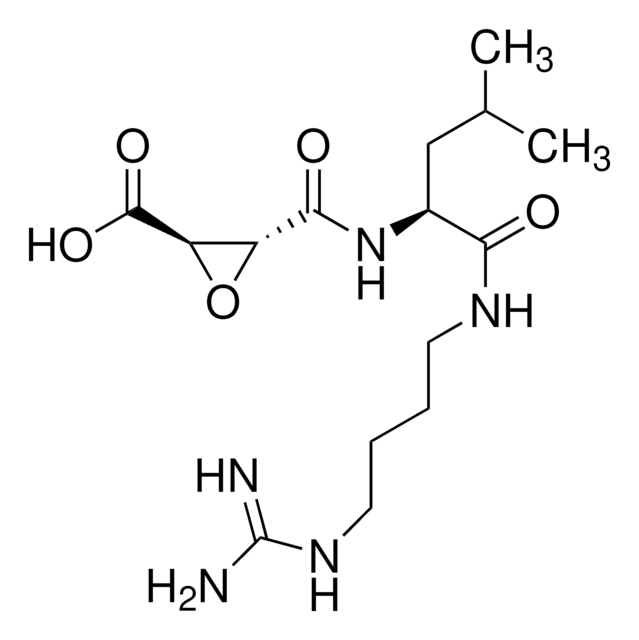11873601001
Roche
Pefabloc® SC PLUS
crystalline, suitable for blocking, suitable for protein purification, 0.1-1.0 mg/mL
Synonym(s):
pefabloc, serine protease inhibitor
About This Item
Recommended Products
form
crystalline
Quality Level
mol wt
239.5
packaging
pkg of 5 mL (100 mg)
manufacturer/tradename
Roche
concentration
0.1-1.0 mg/mL
technique(s)
blocking: suitable
protein purification: suitable
optimum pH
neutral
mp
175-185 °C
solubility
soluble (Solubility and stability of the protease inhibitor remains unchanged.)
storage temp.
2-8°C
General description
Recent findings indicate that sulfonyl-type serine protease inhibitors such as Pefabloc SC and PMSF can bind covalently to proteins. This can occur when the inhibitors are used in high concentrations, or during extended incubation times under alkaline conditions. This interaction adversely affects the tyrosine and lysine residues of a protein, as well as the free amino terminus. The PLUS additive (PSC-Protector) included with this set prevents covalent attachment of Pefabloc SC to proteins when used in higher concentrations and extended incubation times at an alkaline pH.
Specificity
Application
- Pefabloc® SC is used to inhibit the detrimental effects of proteases during preparative protein purification. The PSC-protector solution prevents nonspecific covalent modification of proteins when Pefabloc is used in higher concentrations and extended incubation times at an alkaline pH (tested by mass spectrometry).
- Due to its low toxicity toward eukaryotic cells, it may be applied in the production of recombinant proteins, during fermentation of transformed cells, where proteolytic digestion may decrease the yield of the desired product.
- Pefabloc SC is used to completely inactivate proteinase K during the preparation of chromosomal DNA in agarose plugs. For this purpose, the cells are embedded in agarose and digested with proteinase K to degrade all proteins. Before a specific restriction endonuclease is added, the proteinase K is inactivated by incubating the agarose plugs in 1 – 5 mM Pefabloc SC in 10 mM Tris-HCl, 1 mM EDTA , pH 7 for 2 hours at +37 °C or overnight.
- In contrast to PMSF, Pefabloc SC is an excellent blocker of thrombin activity in serum or plasma. In these biological fluids, PMSF interacts in a reversible manner with albumin, which reduces its free concentration and leads to a delay in thrombin inactivation. Pefabloc SC, however, does not react with serum albumin, and exhibits a threefold higher capacity to inactivate thrombin under similar conditions.
- Pefabloc SC can be used on living cells.
Features and Benefits
- Take advantage of a simplified two-reagent system. Use the PSC-Protector solution to prevent covalent binding between proteins and Pefabloc SC, even at high concentrations, extended incubation times, and at alkaline pH.
- Benefit from an easy-to-use inhibitor. Add water-soluble Pefabloc SC directly to aqueous buffers.
- Avoid hazardous compounds. Obtain non-toxic protease inhibition without risk to you, or those around you.
- Ensure protection with improved stability. Achieve consistent protease inhibition even at pH levels above 7.0 and temperatures above +4°C.
- Maximize inhibition. Be certain that your levels of active inhibitor are high enough by using a product that is reliably soluble and stable.
Packaging
Preparation Note
Pefabloc SC plus the corresponding amount of PSC-protector
Working solution: Recommended solvent is distilled water or aqueous buffer (for Pefabloc SC).
The solubility is up to 0.1 M for Pefabloc SC.
Storage conditions (working solution): -15 to -25 °C (stock solution)
Solubility and stability of the protease inhibitor remains unchanged. See Pefabloc SC.
Reconstitution
Other Notes
Legal Information
Kit Components Only
- Pefabloc SC, 100 mg
- PSC-Protector solution, 5 mL ready-to-use
signalword
Danger
hcodes
Hazard Classifications
Eye Dam. 1 - Flam. Liq. 3 - Skin Corr. 1B
Storage Class
3 - Flammable liquids
wgk_germany
WGK 1
Certificates of Analysis (COA)
Search for Certificates of Analysis (COA) by entering the products Lot/Batch Number. Lot and Batch Numbers can be found on a product’s label following the words ‘Lot’ or ‘Batch’.
Already Own This Product?
Find documentation for the products that you have recently purchased in the Document Library.
Customers Also Viewed
Our team of scientists has experience in all areas of research including Life Science, Material Science, Chemical Synthesis, Chromatography, Analytical and many others.
Contact Technical Service

